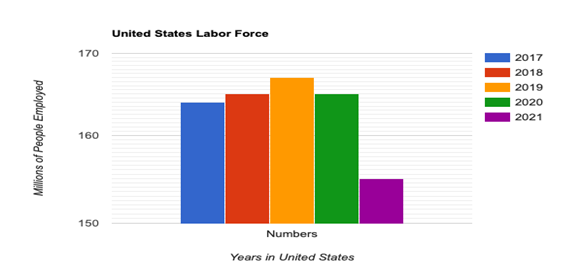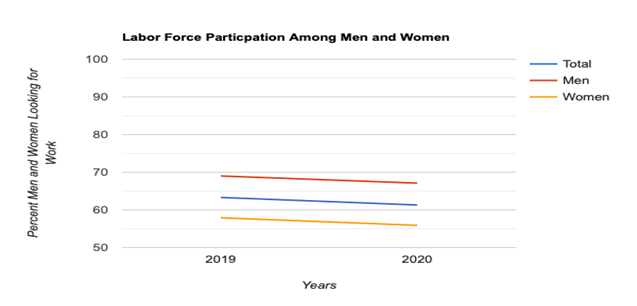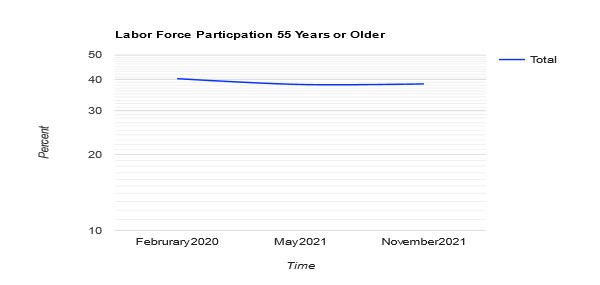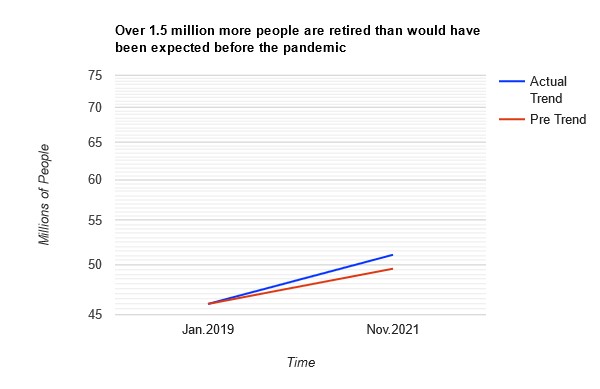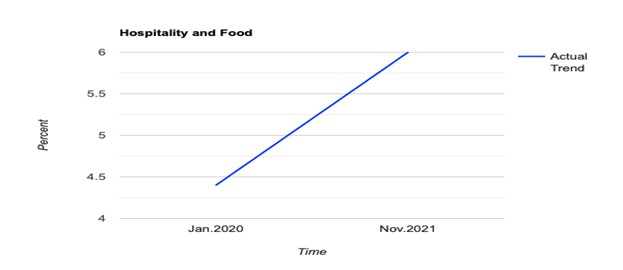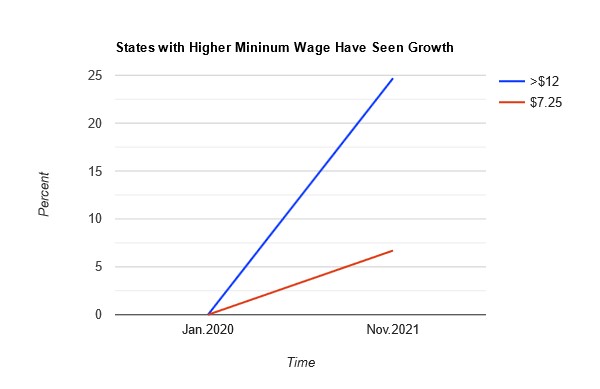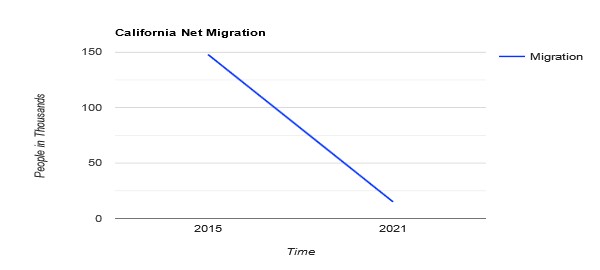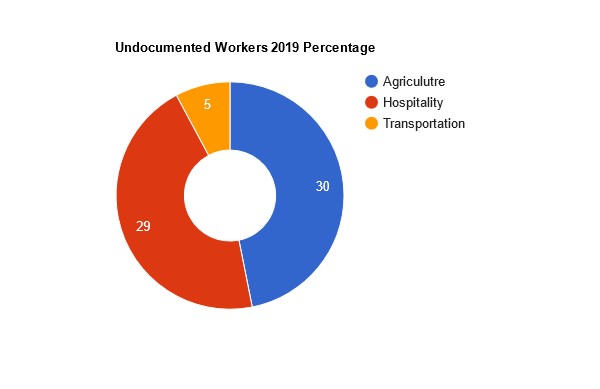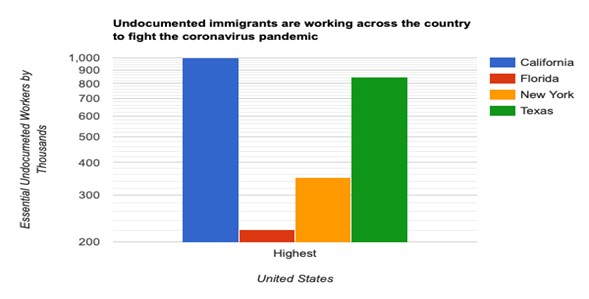The current Labor shortage in 2021 is prominent due to the coronavirus pandemic, early retirement, childcare concerns and low wage conditions. These reasons exacerbates reasons why many workers aren’t going back to work.
- TOTAL WORK FORCE (2017-2021)
The total workforce in the United States has suffered a major labor shortage in the past five years. The total data above of the past five years was retrieved recently on June 15, 2021. As reported from the World Bank, the data acquired shows that the peak of the workforce was reached in 2019 as shown above in the United States Labor Force graph. In 2019, the peak was at 167,329,067 million people employed in the United States.
By 2020, the total labor force dropped down to 165,163,504 million people. Around 2 million people were no longer a part of the workforce. The most recent data for 2021 of the labor force was taken by the Statista research department. In November 2021, a total of about 155.18 million people are employed in the United States. Now showing a decline of 12 million people since 2019. This decline of workers led to the labor shortage contributed by the coronavirus pandemic, early retirement, childcare concerns, and low wage conditions.
- CORONAVIRUS PANDEMIC
The Coronavirus Outbreak began in February 2020 it has led to millions of people leaving the workforce. It is a major prominent reason that is causing the labor shortage right now in the United States. Rakesh Kochhar of The Pew Research Center, reports that “employment in February 2021 is 8.5 million less that of February 2020. (Kochhar, 2021)” This type of loss possibly could take up to three years or more to rebuild the employment structure back to what it was for pre-pandemic trends.
As shown above on the graph of Labor Participation of Men and Women when following the blue line. It shows the labor force participation rate for workers overall was at 63.3% in 2019 to now 61.3% in 2020. According to the Bureau of Labor Statistics data, the low labor participation rate exceeds what has been seen in the great recession in the 1920s (Kochhar, 2021).
The coronavirus pandemic has now caused the greatest recession in United States history. Women accounted for much of the decrease in the labor force compared to men. During the pandemic, the job losses have been the majority in sectors where women account for most of the employment such as hospitality, education, and health services. 2.4 million women and 1.8 million men left the labor force from February 2020 to February 2021.
Anneken Tappe, a reporter of CNN Business, reports that recently in October 2021 that the total job openings rose to 11 million available. Interviewing Nick Bunker, Director of Research at Indeed’s Hiring Lab, tells “Given the rise in openings due to the latest wave of the pandemic, the question is whether the omicron variant cools down the labor market (Tappe, 2021).”
There were only 6.5 million hires reported in October 2021. Compared to how many job openings are still active around 11 million. It shows the labor shortage is a serious issue. There are still a lot more open jobs out there. Due to the coronavirus pandemic, employers are not in a happy mood due to the record number of job openings available. It is difficult for employers to keep up with their businesses or help customers if there are no people to help businesses out.
In 2021, businesses complained that they cannot find workers to fill their open roles. Madison Hoff, a reporter of Business Insider, wrote an article highlighting many reasons why two years into a pandemic were still experiencing a labor shortage.
The United States is still suffering from a major pandemic. Many Americans fear a new variant and have health concerns. Hundreds of thousands of Americans have died from this pandemic. Some workers are still experiencing long-term covid symptoms. S&P Economists stated that 1.4 million workers may not return to work until the pandemic is resolved (Hoff, 2021).
There are some Americans out there who are staying out of work or leaving work due to the vaccine mandates. Some Americans are hesitant to receive a vaccine as businesses are now starting to acquire mandates to receive vaccines. The Coronavirus pandemic is a prominent reason were experiencing a record labor shortage in the country right now. If this pandemic did not exist, we would not be seeing so many jobs open as people are scared to go to work due to health concerns.
- EARLY RETIREMENT
Early Retirement is another concerning factor that is serious with the labor shortage occurring in this country as of now. As reported by Anneken Tappe, for CNN Business, she states the labor force participation rate for workers over 55 has remained surprisingly low.
In the graph below of Labor Participation of 55 years or older. It shows, In February 2020 pre-pandemic it was at 40.3%, by May 2021 it hit a record low at 38.2%, currently in November 2021 it is at 38.4% (Tappe, 2021).
Some older workers are currently being benefited from the stock market or the current rising house market. These seniors can consider early retirement as a good decision. Others have had an unlucky time. Some older workers have been laid off and furloughed. Older workers have already considered being a high-risk group for the pandemic are even in worse conditions with also being unemployed. Places are more willing to hire younger people with more education (Tappe, 2021). Jobs such as retail or food services receive a higher chance of infection risk. This will turn off older workers from applying.
The Washington Post released an article called “The Most Unusual Job Market in History” by reporter Alysa Flowers. She states that over 1.5 million more people were retired in November 2021 than what was expected due to the pre-pandemic trends.
As shown in the graph below it can be shown on November 2021, 51.1 million people retired compared to 49.6 million for the pre-pandemic trends (Flowers, 2021). High retirement accounts and home values, combined with working from home made it easy for people to retire early. Others have retired solely on social security.
In the graph below of Labor Participation of 55 years or older. It shows, In February 2020 pre-pandemic it was at 40.3%, by May 2021 it hit a record low at 38.2%, currently in November 2021 it is at 38.4% (Tappe, 2021).
Some older workers are currently being benefited from the stock market or the current rising house market. These seniors can consider early retirement as a good decision. Others have had an unlucky time. Some older workers have been laid off and furloughed. Older workers have already considered being a high-risk group for the pandemic are even in worse conditions with also being unemployed. Places are more willing to hire younger people with more education (Tappe, 2021). Jobs such as retail or food services receive a higher chance of infection risk. This will turn off older workers from applying.
The Washington Post released an article called “The Most Unusual Job Market in History” by reporter Alysa Flowers. She states that over 1.5 million more people were retired in November 2021 than what was expected due to the pre-pandemic trends.
As shown in the graph below it can be shown on November 2021, 51.1 million people retired compared to 49.6 million for the pre-pandemic trends (Flowers, 2021). High retirement accounts and home values, combined with working from home made it easy for people to retire early. Others have retired solely on social security.
Alfred Marcus, a professor of strategy and technology leadership at the University of Minnesota was interviewed by reporter Sabri Ben Achour for Marketplace. Alfred Marcus believes this labor shortage will last much longer due to our workplace population aging. Alfred discusses that much of the population that is 55 years or older have decided to take early retirement which is highly uncommon. Especially those that have not attended universities.
There are currently more jobs available than people looking for work. Alfred Marcus states there has been a major increase in the retired population in general as it has gone up from 15% to 20% from 2015 to 2020. The labor shortage will continue as we lead into a much likely shrinking working population due to the pandemic with people retiring early (Achour, 2021). With people retiring early, this leaves a big gap than what we had before the pandemic. Early retirement is one of the reasons for this labor shortage.
- CHILDCARE AND CARETAKING
Currently, the lack of childcare is one of the prominent causes for why the labor shortage is currently prevalent. Madison Hoff, reporting for Business Insider on the many reasons why America is in a labor shortage, states that “some working parents had to leave the workforce completely because they do not have access to daycare or have to take on extra caretaking responsibilities (Hoff, 2021).
Daycares are currently experiencing low employment compared to pre-pandemic trends. Causing Americans to struggle with working when they must take care of children or even elderly parents in their households. Laura Beshnoff, reporting for PBS, talks about currently there is a shortage of childcare workers across the state of Pennsylvania.
There are thousands of fewer spots for children to be accepted to daycare is causing a strain for working parents to return to the workforce (Beshnoff, 2021). In Pennsylvania, more than 92% of childcare respondents were short staffed and more than 25,000 children sit on waitlists to be accepted to a daycare.
Claire Cain Miller, a reporter of the New York Times, is reporting that even Biden Administration is trying to figure out a solution to the childcare issue that is impacting the labor shortage. The labor shortage is being impacted due to the pandemic. Some daycare centers went out of business. Many children cannot get the vaccine under the age of 12, so daycare centers are only accepting a minimal number of children (Miller, 2021). The major issue across the country is there are not enough people to hire to work in childcare.
People looking for work are saying that working in retail or restaurants is paying more than at a childcare center. Working at a childcare center requires being with unvaccinated children, requires more qualifications, and background checks. Which can turn off people from applying. Until childcare wages raise higher it will be difficult for people to want to work in childcare. If childcare facilities decline, it will lead to more people leaving the workforce to take care of their children.
- LOW WAGE CONDITIONS
Low Wage conditions are another one of the main reasons many Americans are not returning to work. Low wages make people realize it is not worth it to take on a job during the global pandemic. People begin to realize they should be paid more for their time and have better benefits for their jobs.
In the news article, “The Most Unusual Job Market in Modern History” from The Washington Post, reporter Alyssa Flowers interviews Bernard Baumohl, the chief global economist, at the Economic Outlook Group. Bernard states that the industry affected the most in Low Wage sectors are the restaurant and hospitality industry.
The people in those industries are no longer willing to work for low wages or in conditions they experienced during the pandemic. Job Openings in restaurants are now at record highs.
The sector affected most by the labor shortage are the hospitality and food sectors. As shown in the graph above, compared to before the pandemic the quit rate was at 4.5% but from the most recent data shows, the quit rate has jumped to 6%. Hospitality and food services hold the highest quit rate among the industries (Flowers, 2021).
A report was done by senior researcher Nicole Bateman for Brookings University on Low Wage Workers in the pandemic. It shows that 40% of Low Wage workers were in hospitality. This sector has the farthest to go in recovery as it is down in 2.2 million jobs (Bateman, 2021).
The federal minimum wage has been at $7.25 for 12 years. It has lost up to 21% of its value due to inflation. Minimum wage workers cannot afford rent anywhere in the nation according to the National Low Income Housing Coalition. Good wages and workers’ benefits not being offered are the reason there is a massive labor shortage in America right now.
CAP released a report supporting higher wages to support job growth during the pandemic. Kyle Ross reports that having a $15-dollar minimum wage would help the 32 million Low Wage workers in the country. It would help lift 3.7 million people out of poverty (Ross, 2021).
As shown in the graph above, states with a minimum wage or higher of $12 saw a growth of employment across all industries of about 25%. With states that only had the minimum federal wage of $7.25 only had a growth of 6.7% (Ross, 2021). More jobs are being obtained in states that have higher wages which initiate higher job growth. If businesses offered better wages and benefits it will help shrink the labor shortage currently going on. People are more willing to go back to work if they are treated fairly.
- UNDOCUMENTED IMMIGRANTS
The Pew Research Center reports that the last reported population of unauthorized immigrants in the United States is 10.5 million in 2017. Undocumented immigrants make up about 23% of the United States Population. Undocumented workers have been highly affected by the pandemic. They have had a lack of access to healthcare, government relief payments, and job instability. Leaving Undocumented immigrants highly vulnerable during this pandemic.
Due to the global pandemic, immigration to the United States has slowed. It could be beneficial in industries such as construction which is currently facing a labor shortage. David Bier for the Canto Institute states that “there are about 2.1 million work eligible immigrants are not here due to the restrictions being imposed during the pandemic. (Hoff, 2021).”
As reported by Homeland Security, Undocumented Immigrants have been deported each year as well. In 2017, 287,093 immigrants were removed. In 2018, 328,716 immigrants were removed. In 2019, 359,885 immigrants were removed from the last reported data on deportations. These immigrants could have been vital to helping cover the labor shortage going on currently. If they were allowed to work in the industries that need workers. The United States Census Bureau reports that through June 2021, land borders have closed between Canada, the United States, and Mexico remains closed to nonessential travel.
Florida, Texas, California, and Massachusetts typically gain the most migrants. But have received a 50% drop between 2020 to 2021 due to the global pandemic. As shown below in the graph, California received the biggest drop from 148,000 migrants in 2015 to only 15,000 in 2021.
As reported by the Center of American Progress, nearly 5 million essential undocumented immigrants are working to keep this country safe out of the 7 million total undocumented immigrants currently here. They are making sure produce from the fields gets to the grocery stores, working in the healthcare industry, taking care of children and the elderly, and ensuring the infrastructure stays safe.
Nicole Svajlenka, a reporter for CAP, reports that undocumented workers pay $47.2 billion in federal taxes and $25.5 billion in state and local taxes (Svajlenka, 2021). Congress should use all the necessary tools to make sure the work these essential undocumented workers do during this pandemic does not go unnoticed. Undocumented Immigrants should be put on a pathway to citizenship.
Currently, there are more than 7 million undocumented workers working in the United States. They make up 4.4 % of the workforce (Svajlenka, 2021). From the most recent account by the Department of Agriculture Census of Agriculture, there are 2.4 million farmworkers in the United States and the U.S. Department of Labor’s National Agricultural Workers Survey finds that 49 percent of workers in that field are undocumented immigrants.
A table done for the American Center of Progress in 2019 shows how many undocumented immigrants work and how much percent of them work in that industry. As shown below, In Agriculture there were 233,100 workers accounted making 30% of the share of farmworkers. In Hospitality, undocumented workers working as cooks, waiters, and food preparation made up a total of 570,1000 people. Accounting for 29% of the industry. In transportation, undocumented workers working as drivers and truck drivers were 176,500 people. Accounting for 5% of the industry.
Undocumented workers have put their safety on the line to help Americans during the pandemic. Farmworkers have picked crops, workers in processing plants continued their work, and truckers have hauled food across the country.
The Center for American Progress released data showing the most essential undocumented workers are in the states of California, Florida, Texas, and New York. As shown below, California has 998,200 undocumented workers. Texas has 845,900 undocumented workers. New York has 350,400 workers and Florida has 222,700 undocumented workers.
Bringing in more immigrants would help shrink the labor shortage even on work visas or give them permanent citizenship. Nicole Naera, a reporter of Vox, shared a study done by the New American Economy. Food Services and Construction have both had a 77% increase in job postings. Undocumented workers make up a quarter of the share of the workforce in both (Naera, 2021).
Tony Rader, senior vice president of National Roofing Partners says they have hired temporary workers on H-2 visas due to the labor shortage. Immigrants are willing to do jobs most Americans are not willing to do. Currently, the United States needs roughly 11 million jobs filled and only 8.4 million Americans are looking for work (Naera, 2021).
Immigrants can help bridge that gap and help end the labor shortage. Immigrants are willing to go to where the jobs are located for a better opportunity. Immigrants can help solve the labor shortage problem by implementing themselves in areas that have better opportunities. This can lead to better economic recovery for the country.
The Biden Administration can help expand the H-2 visa program. Which helps bring in workers internationally. It is popular to work seasonally in industries such as tourism to fishing. The Biden Administration can bring in 130,000 additional H-2 visas yearly. There are limitations to the program as it will not offer immigrants permanent residence within the country (Naera, 2021). With a better immigration policy, more undocumented workers can help end the labor shortage and help strengthen the economy.
- Alternative Look at Labor Shortage
There are some out there who believe that the labor shortage is a small issue. Roy Maurer, a reporter for SHRM, interviews Gad Levanon, head of The Labor Market Institute at The Conference Board in New York City. Levanaon believes that if schools reopen sooner, it will help ease the childcare crisis. With federal unemployment benefits coming to an end, it will lead to many people returning to the workforce (Maurer, 2021).
Daniel Zhao, a senior economist for Glassdoor, tells Business Insider reporter Madison Hoff that calling employer demand and employment issues a labor shortage is not the right assessment. Zhao believes workers are choosing not to participate in the workforce due to various reasons. Not that there is no availability of capable workers (Hoff, 2021).
If Employers can recognize employees are looking for a career and community, not just a job then more people would be returning to the workforce. Zhao says If Employers can offer career development opportunities, employee engagement, better benefits, and wages. It can help industries navigate better through these turbulent times (Hoff, 2021).
WORK CITED PAGE
- TOTAL WORK FORCE (2017-2021)
“Labor Force Total – United States” (https://data.worldbank.org/indicator/SL.TLF.TOTL.IN?end=2020&locations=US&start=2017)
“Monthly employment level of the United States from November 2020 to November 2021” (https://www.statista.com/statistics/209123/seasonally-adjusted-monthly-number-of-employees-in-the-us/)
- CORONAVIRUS PANDEMIC
“U.S. labor market inches back from the COVID-19 shock, but recovery is far from complete” (https://www.pewresearch.org/fact-tank/2021/04/14/u-s-labor-market-inches-back-from-the-covid-19-shock-but-recovery-is-far-from-complete/)
“America’s job openings jumped to 11 million in October” (https://www.cnn.com/2021/12/08/economy/job-openings-quits-october/index.html)
“13 reasons that help explain the labor shortage in the US”
- EARLY RETIREMENT
“Three key numbers that explain America’s labor shortage” (https://www.cnn.com/2021/12/25/economy/labor-shortage-early-retirement-charts/index.html)
“The most unusual job market in modern American history, explained” (https://www.washingtonpost.com/business/2021/12/29/job-market-2021/)
“Why the labor shortage may go on for much longer”
(https://www.marketplace.org/2021/11/03/why-the-labor-shortage-may-go-on-for-much-longer/)
- CHILDCARE AND CARETAKING
“13 reasons that help explain the labor shortage in the US”
“Underlying all the labor shortages? A ‘crisis’ in the child care sector creating a vicious cycle for working parents”
‘Can’t Compete’: Why Hiring for Child Care Is a Huge Struggle
(https://www.nytimes.com/2021/09/21/upshot/child-care.html)
- LOW WAGE CONDITIONS
“The most unusual job market in modern American history, explained” (https://www.washingtonpost.com/business/2021/12/29/job-market-2021/)
“The pandemic hurt low-wage workers the most—and so far, the recovery has helped them the least”
“Higher Minimum Wages Support Job Growth as the Economy Recovers From COVID-19”
- UNDOCUMENTED IMMIGRANTS
“Key facts about the changing U.S. unauthorized immigrant population” (https://www.pewresearch.org/fact-tank/2021/04/13/key-facts-about-the-changing-u-s-unauthorized-immigrant-population/)
“13 reasons that help explain the labor shortage in the US”
“Table 39. Aliens Removed or Returned: Fiscal Years 1892 to 2019”
(https://www.dhs.gov/immigration-statistics/yearbook/2019/table39)
“New Population Estimates Show COVID-19 Pandemic Significantly Disrupted Migration Across Borders”
“Protecting Undocumented Workers on the Pandemic’s Front Lines”
(https://www.americanprogress.org/article/protecting-undocumented-workers-pandemics-front-lines-2/)
“Immigrants could fix the US labor shortage”
- Alternative Look at Labor Shortage
“Labor Shortages: The Disconnect and Possible Solutions”
“ Why it’s not really a labor shortage, according to the author of a report that just crunched data on millions of job searches and reviews”

